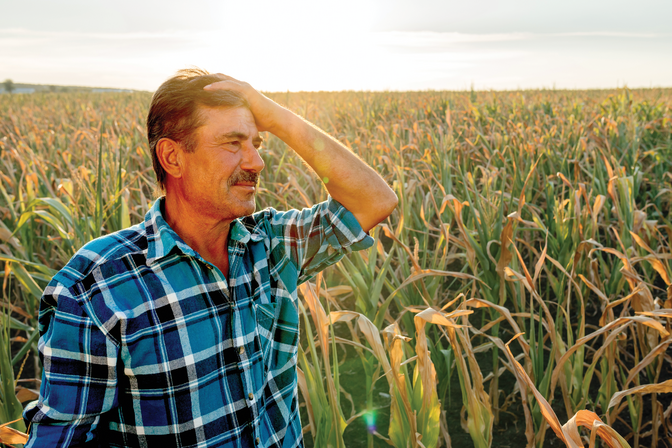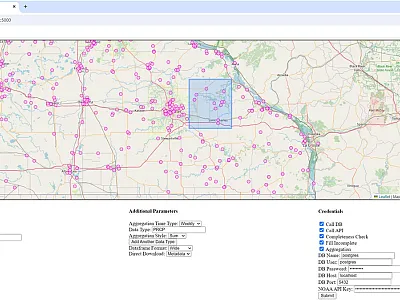Fifth National Climate Assessment Released

The U.S. Global Change Research Program (USGCRP) recently released its Fifth National Climate Assessment (NCA5; https://nca2023.globalchange.gov/). The report, delivered to Congress and the president, “…analyzes the effects of global change on the natural environment, agriculture, energy production and use, land and water resources, transportation, human health and welfare, human social systems, and biological diversity; and analyzes current trends in global change, both human‐induced and natural, and projects major trends for the subsequent 25 to 100 years.” The NCA5 summarizes and evaluates the state of the science on climate change and provides policy‐neutral information to decision‐makers at local, state, and national levels, as well as Tribal governments, about potential impacts of climate change and opportunities for addressing them.
Of particular interest to CSA News readers is “Chapter 11—Agriculture, Food Systems, and Rural Communities.” This chapter discusses the serious challenges climate change poses to U.S. agricultural production, food systems, and rural communities. Based on our author team’s review of pertinent literature, followed by input and detailed comments from many—including the general public, the Federal Steering Committee, and an ad hoc committee of the National Academies of Science, Engineering, and Math—three key messages emerged for this chapter of the NCA5.
Important Disruptions to Agriculture
In Key Message 1, we highlighted several important disruptions to agriculture caused by a changing climate. The northward migration of plant hardiness zones will require changes in agricultural practices such as crop selection, equipment, and management approaches. Combatting soil degradation caused by climate change will require adoption of conservation practices that improve soil health. While increasing efficiency has lowered greenhouse gas (GHG) emissions per unit of agricultural productivity, total GHG emissions from U.S. agriculture have been steadily rising over the past 30 years. We emphasized that adopting agroecological approaches with a focus on soil health, adaptive conservation management, diversification of landscapes, and climate‐smart practices that target the right amount, source, placement, and timing of nitrogen fertilizers can lead to increased productivity, resilience to climate change, and reductions in GHG emissions. We defined agroecological approaches as “land management practices that integrate biophysical, technological, and social concepts and principles to guide the design and management of food and agricultural systems.” This definition encompasses subsistence and organic farming as well as the judicious use of technological interventions (such as climate‐smart practices). More high quality/high resolution data will be needed to provide decision makers with the information needed to effectively manage agriculture and improve resilience and adaptability to climate change.
All Dimensions of Food Security Will Be Adversely Affected
In Key Message 2, we emphasized that climate change is expected to adversely affect all dimensions of food security—availability, accessibility, usability, and stability. Compounding effects, such as heat waves occurring during a drought, make our complex food systems even more vulnerable. For example, climate change is projected to double the number of unsafe working days for farmworkers by mid‐century while drought simultaneously reduces the income of already food‐insecure farmworkers and thus their ability to buy food. Food system disruptions occur at local, regional, national, and international levels, and are projected to affect the affordability of some foods. Increased food prices are expected to disproportionally affect women, children, older adults, and low‐wealth communities. Climate change may also affect the ability to obtain food through hunting, foraging, fishing, and subsistence farming. Greenhouse gas (GHG) emissions from various aspects of the food system were also discussed. Reducing food loss and waste can reduce GHG emissions and increase food security. While the impacts of climate change on food production have been measured, the socioeconomic costs to food processing, distribution, and consumption are less well understood.
Rural Community Impacts, Challenges, and Opportunities
In Key Message 3, we described the impacts and unique challenges and opportunities faced by rural communities to a changing climate. Rural communities manage much of the nation’s land and natural resources, have unique knowledge of rural landscapes, and supply labor for agricultural production and other economic sectors. Budgetary and social constraints along with the increasing rate and severity of climate disasters create disproportionate hardships in rural communities. The resiliency of rural communities to climate change is hindered when climate risks are compounded by historical environmental justice inequities. Recent studies have shown risks to rural communities beyond what can be quantified in terms of expected annual monetary losses. Devastation to rural Alaska fishing communities following the unprecedented marine heat wave in the Gulf of Alaska from 2014 to 2016 was used as an example of the risk that climate change poses to resource‐based rural communities. We used six broad categories included in the Baseline Resilience Indicators for Communities (BRIC) index to show geographic variation in the factors which contribute most to resilience among rural counties across the U.S.
You can find read the full chapter at https://nca2023.globalchange.gov/chapter/11/.
Key Messages
- Agricultural Adaptation Increases Resilience in an Evolving Landscape. Climate change has increased agricultural production risks by disrupting growing zones and growing days, which depend on precipitation, air temperature, and soil moisture. Growing evidence for positive environmental and economic outcomes of conservation management has led some farmers and ranchers to adopt agroecological practices, which increases the potential for agricultural producers to limit greenhouse gas emissions and improve agricultural resilience to climate change.
- Climate Change Disrupts Our Food Systems in Uneven Ways. Climate change is projected to disrupt food systems in ways that reduce the availability and affordability of nutritious food, with uneven economic impacts across society. Impacts of climate change on other measures of human well‐being are also distributed unevenly, such as worsening heat stress among farmworkers and disruptions to the ability of subsistence‐based peoples to access food through hunting, fishing, and foraging.
- Rural Communities Face Unique Challenges and Opportunities. Rural communities steward much of the nation’s land and natural resources, which provide food, bioproducts, and ecosystem services. These crucial roles are at risk as climate change compounds existing stressors such as poverty, unemployment, and depopulation. Opportunities exist for rural communities to increase their resilience to climate change and protect rural livelihoods.
Text © . The authors. CC BY-NC-ND 4.0. Except where otherwise noted, images are subject to copyright. Any reuse without express permission from the copyright owner is prohibited.







